Birdfinding.info ⇒ Common across much of its large range, especially in south-central South America: central Chile, and the band from Córdoba east through Argentine Mesopotamia to Uruguay and south-coastal Brazil. Also in the Pantanal and in several wetland complexes along the eastern flank of the Andes, such as the ricefields of San Martín, Peru, the Cochabamba Valley in Bolivia, and the Salta Valley in Argentina. More localized or sporadic elsewhere.
White-backed Stilt
Himantopus melanurus
Central and southern South America, in ponds, lagoons, and marshes with expanses of shallow water.
Breeds across a wide swath of South America from the central Peruvian Andes and Amazonian foothills southeast through central Bolivia and across the Chaco, Pantanal, and southern cerrado region to Rio de Janeiro, and south to Patagonia (southern Chubút). Also in the Pacific lowlands of Chile from southern Atacama south to Chiloé Island.
Largely resident in most of its range, but partly nomadic, regularly dispersing across north-central Peru and eastern Brazil, and along the Pacific coast of northern Chile and Peru. It has been recorded at least twice on the Falkland Islands.
A zone of occasional or regular overlap with Black-necked Stilt (H. mexicanus) extends from the intermontane valleys of northern Peru across the western portion of the Amazon Basin to Rondônia, then across most of central and eastern Brazil—where both forms occur at least somewhat regularly throughout the states of Goiás, Tocantins, Minas Gerias, Bahia, Espírito Santo, and Rio de Janeiro.
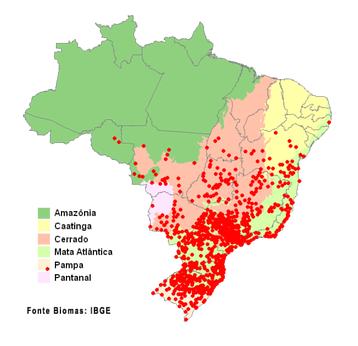
Brazilian records from © Wikiaves
Identification
Distinctive and unlikely to be mistaken for anything except another stilt: a large shorebird with a long neck, a straight or slightly upcurved, thin, black bill, extraordinarily long pink legs, and crisply contrasting black-and-white plumage.
Predominantly black on the upperparts, including the back of the neck and the wings. The rest of its plumage is white—including a bar across the mantle which separates the black on the neck from the black on the back.
On adults the head is mostly white, with black limited to the hindcrown and a line that extends back from the eye.
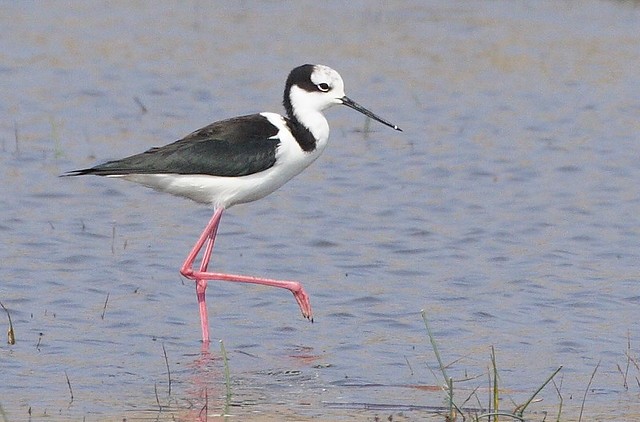
White-backed Stilt. (Mantagua, Valparaíso, Chile; April 6, 2007.) © Pablo Contreras Cáceres
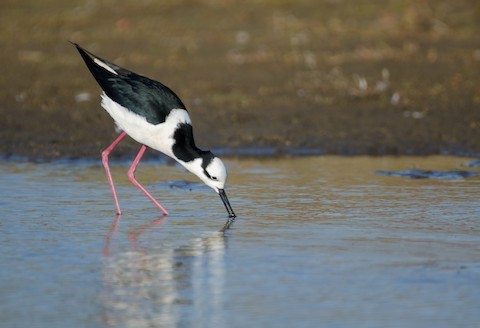
White-backed Stilt, male showing the white bar across its mantle. (Estero Cartagena, Valparaíso, Chile; September 2, 2018.) © Pablo Gutiérrez Maier

White-backed Stilt, male. (Tanquã, Piracicaba, São Paulo, Brazil; September 11, 2016.) © Antônio Bordignon

White-backed Stilt, male showing the white bar across its mantle. (Laurentino, Santa Catarina, Brazil.) © Miguel Angelo Biz

White-backed Stilt, male showing the white bar across its mantle. (March 15, 2014.) © Alessandra
Males typically appear jet-black on the upperparts, or sometimes show a greenish sheen.
When seen at close range, females and older immatures typically appear dark-brown instead of jet-black on the scapulars (i.e., most of the “back”).

White-backed Stilt, male showing greenish sheen on black upperparts. (Parque Linear Nove de Julho, São Paulo, Brazil; July 6, 2018.) © Luciano Bernardes
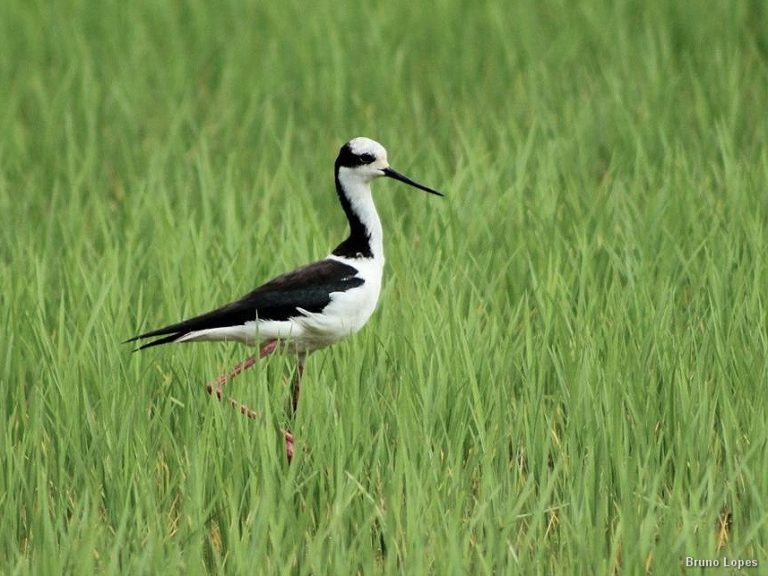
White-backed Stilt, male showing the white bar across its mantle. (Gaspar, Santa Catarina, Brazil; October 16, 2010.) © Bruno Lopes

White-backed Stilt, male showing a bluish sheen on black upperparts. (Laurentino, Santa Catarina, Brazil.) © Miguel Angelo Biz
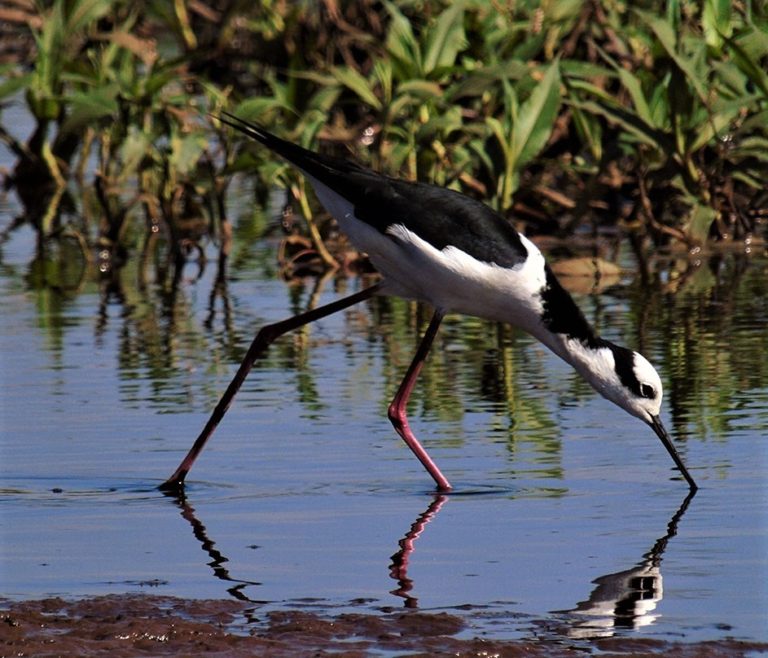
White-backed Stilt, male showing the white bar across its mantle. (Capivari, São Paulo, Brazil; June 26, 2017.) © Varly Braghieri

White-backed Stilt, male showing broad white bar across its mantle. (Niterói, Rio de Janeiro, Brazil; July 25, 2020.) © Ricardo Mitidieri
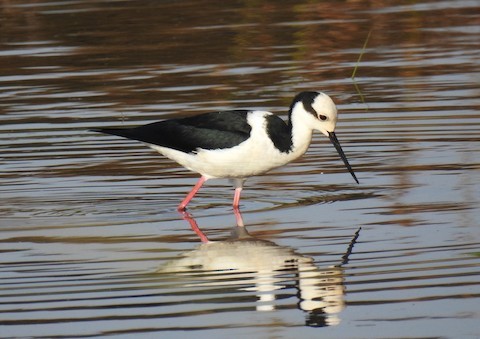
White-backed Stilt, male showing broad white bar across its mantle. (Não-Me-Toque, Rio Grande do Sul, Brazil; May 3, 2018.) © Jonas Kilpp

White-backed Stilt, male. (Fazenda Souza, Paraná, Brazil; April 21, 2020.) © Giovan Alex
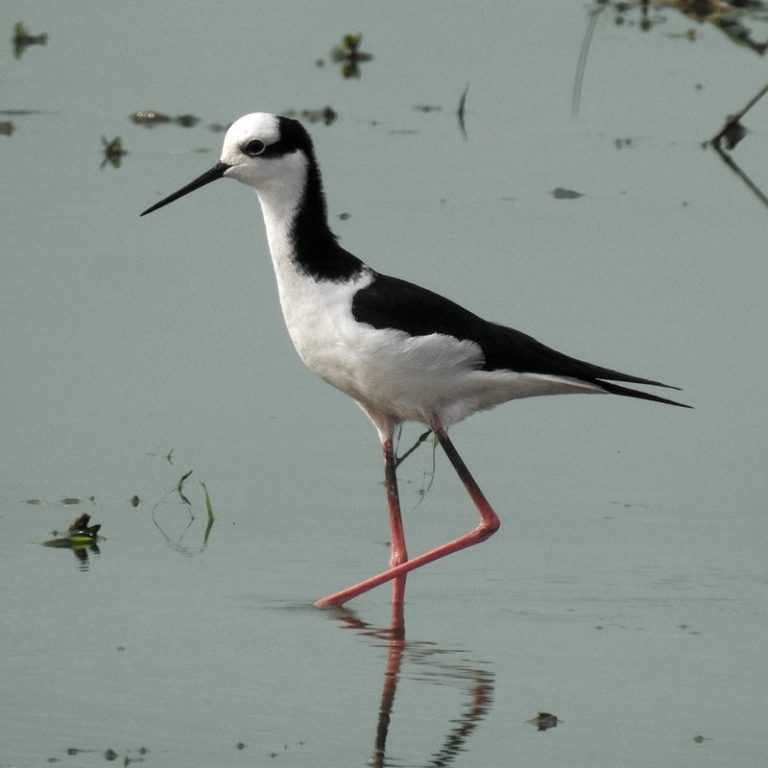
White-backed Stilt, male showing that the white bar across its mantle can be inconspicuous. (Candelária, Rio Grande do Sul, Brazil; June 16, 2019.) © Roberta Rödel
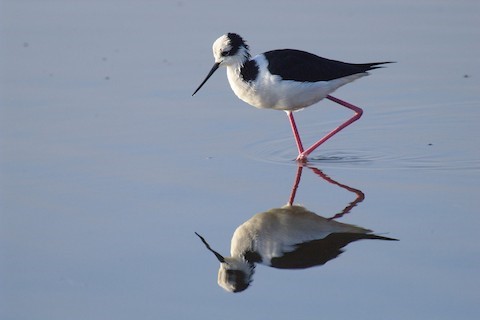
White-backed Stilt, male showing the white bar across its mantle. (Punta Teatinos, La Serena, Coquimbo, Chile; March 17, 2008.) © Etienne Artigau

White-backed Stilt. (Tramandaí, Rio Grande do Sul, Brazil; May 9, 2020.) © Marcelo Fernandes

White-backed Stilt, male. (Pedreira, São Paulo, Brazil; June 3, 2018.) © Luciano Bernardes
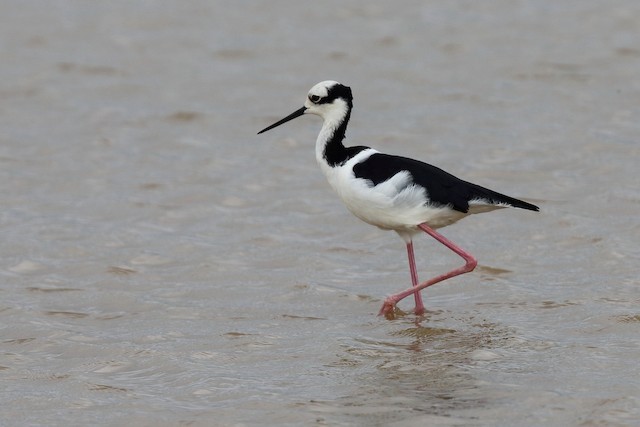
White-backed Stilt, male. (Jardim, Rio Grande do Sul, Brazil; January 3, 2016.) © Josef Widmer
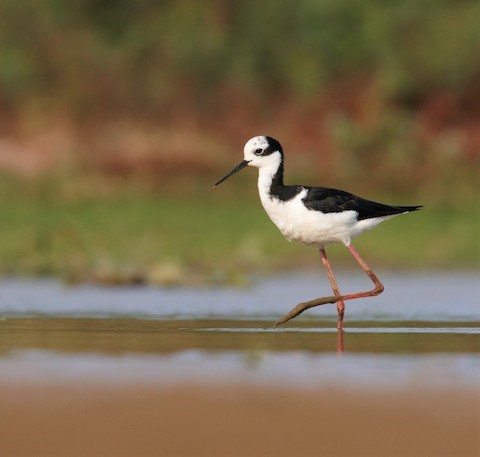
White-backed Stilt, with possibly incomplete white bar on mantle. (Lagunas Banco San Miguel, Asunción, Paraguay; September 20, 2020.) © Carl Thomson

White-backed Stilt, male showing broad white bar across its mantle. (Universidade Federal de São Carlos, São Paulo, Brazil; August 2, 2019.) © Celso Modesto Jr.
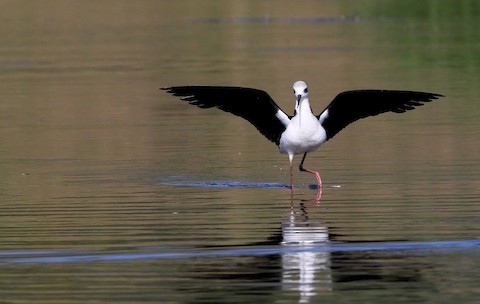
White-backed Stilt, showing black underwings with white inner coverts. (Parque del Bicentenario, Capital, Salta, Argentina; November 24, 2017.) © Patrick Monney
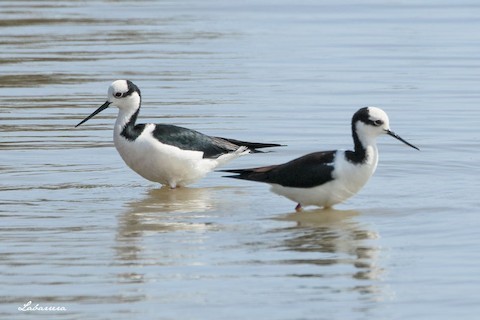
White-backed Stilt, male at left, female at right. (Río Maipo mouth, San Antonio, Chile; September 20, 2017.) © Gonzalo Labarrera
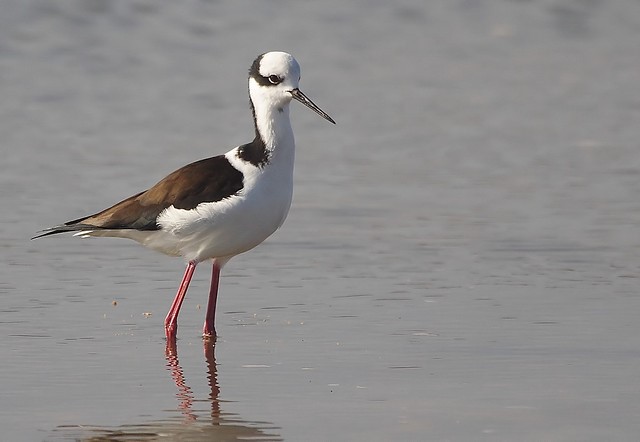
White-backed Stilt, female. (Cartagena Estuary, Valparaíso, Chile; July 1, 2009.) © Pablo Andrés Cáceres Contreras
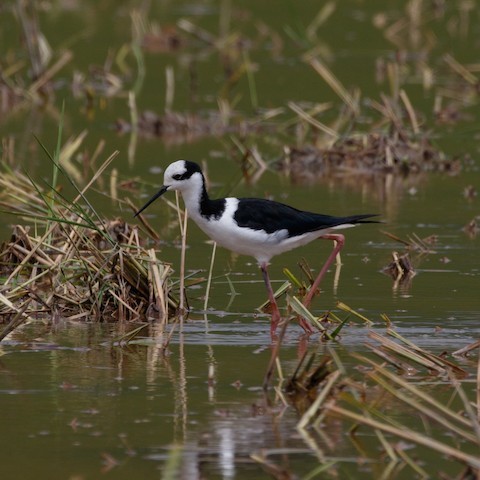
White-backed Stilt, male showing subtle bluish sheen on black upperparts. (Tremembé, São Paulo, Brazil; January 13, 2017.) © Silvia Faustino Linhares
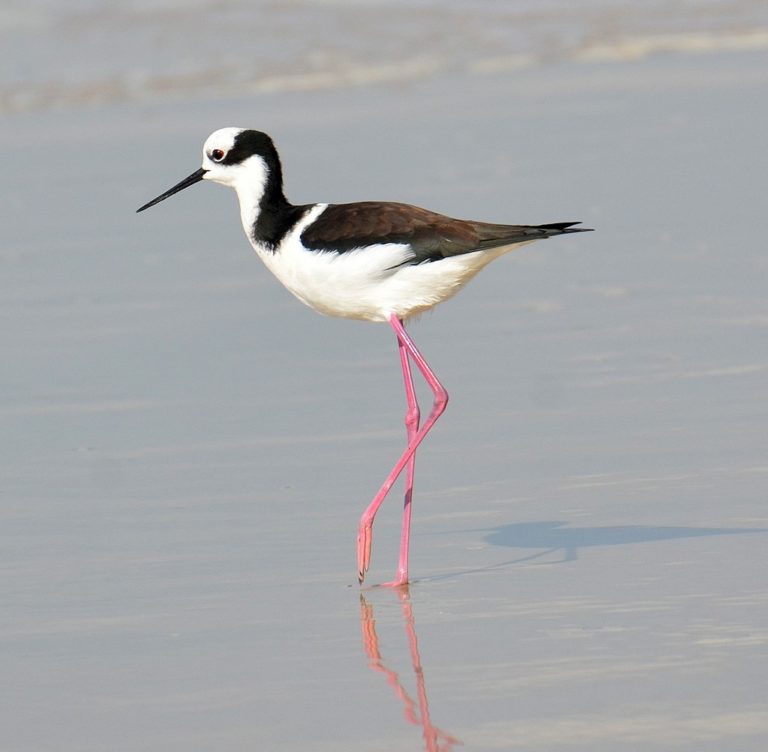
White-backed Stilt, female. (Mostardas, Rio Grande do Sul, Brazil; June 28, 2013.) © Cesar Santos

White-backed Stilt, female. (Río Maipo Estuary, Santo Domingo, Valparaíso, Chile; February 9, 2019.) © Chris Burwell

White-backed Stilt. (Margem Caí, Capela de Santana, Rio Grande do Sul, Brazil; May 30, 2020.) © Leonildo Piovesan
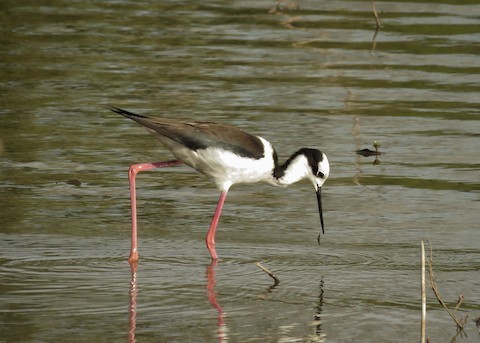
White-backed Stilt, female. (Pesqueiro do Mauricião, São Paulo, Brazil; July 19, 2019.) © Arthur Gomez
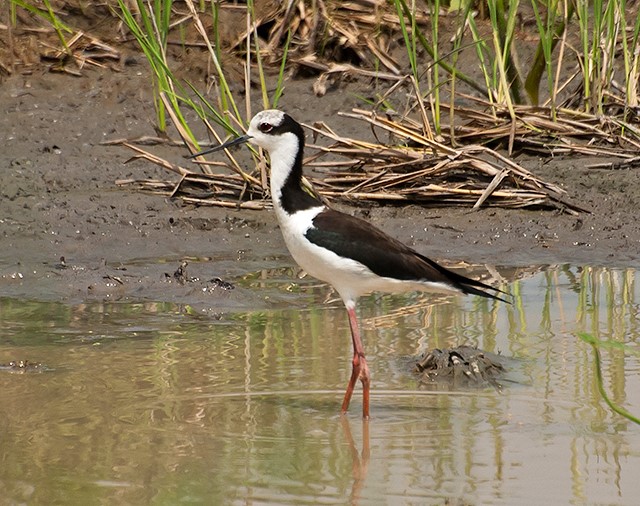
White-backed Stilt, female. (Tremembé, São Paulo, Brazil; March 29, 2015.) © Dario Sanches
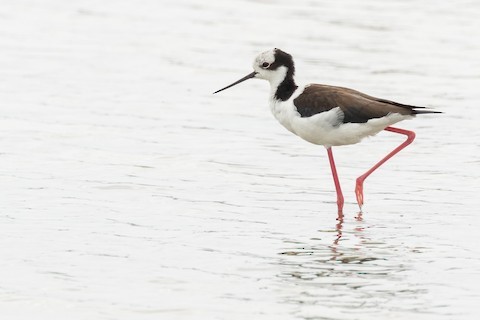
White-backed Stilt, female. (Salina Maré, Ararauma, Rio de Janeiro, Brazil; January 18, 2020.) © Sergio Porto
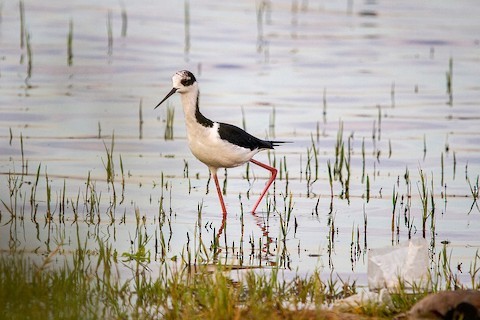
White-backed Stilt, showing some remnant black feathers on the crown. (Represa de Guarapiranga, São Paulo, Brazil; July 12, 2018.) © Laerte Cardim
Juveniles are less crisply marked than other age classes, often appearing brownish and smudgy.
They differ strikingly from older birds in that their heads and mantles are almost all-dark (thus resembling Black-necked Stilt—see below). As they progress toward adulthood, the head and mantle become whiter in stages.
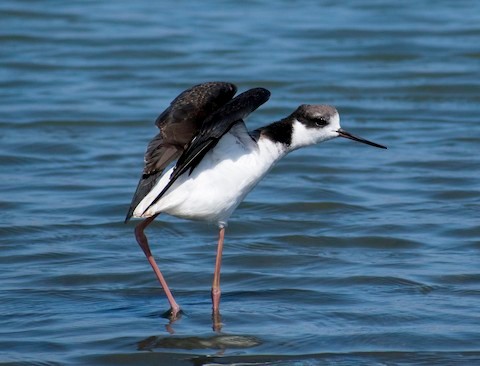
White-backed Stilt, juvenile with mostly blackish crown. (La Laguna, Zapallar, Valparaíso, Chile; January 25, 2020.) © Pablo Bravo Araya

White-backed Stilt, immature with crown molting from black to white. (Pousada Piuval, Mato Grosso, Brazil; October 20, 2018.) © Nick Bonomo

White-backed Stilt, immature female with crown molting from black to white. (Mar Chiquita, Buenos Aires Province, Argentina.) © Oscar Rebuffone
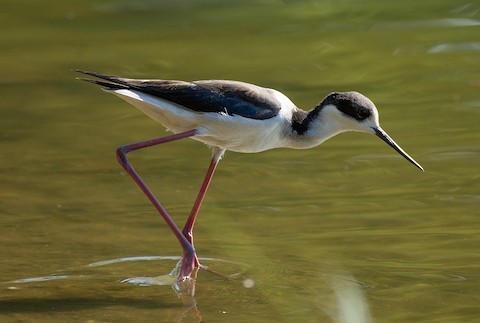
White-backed Stilt, immature with crown molting from black to white. (Parque Ibirapuera, São Paulo, Brazil; May 29, 2018.) © Luciano Bernardes
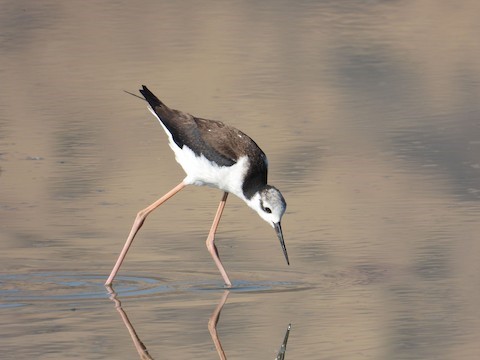
White-backed Stilt,apparently a juvenile or immature female with a mostly whitish crown. (Laguna Batuco, Lampa, Santiago Metropolitan Region, Chile; January 21, 2019.) © Chris Burwell

White-backed Stilt, showing remnants of black feathering on the crown. (Tramandaí, Rio Grande do Sul, Brazil; September 18, 2010.) © Caco Schwertner

White-backed Stilts, with crowns of varying amounts of black remaining. (Xangrilá, Rio Grande do Sul, Brazil; January 2, 2019.) © Paulo Krieser
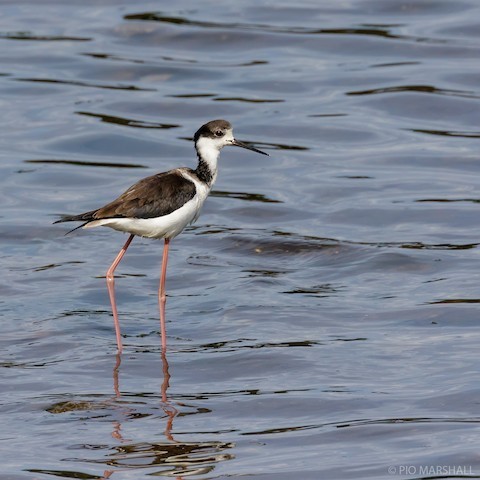
White-backed Stilt, juvenile with mostly blackish crown. (Lago Budi, Puerto Domínguez, Araucanía, Chile; February 21, 2018.) © Pio Marshall

White-backed Stilt, immature with crown molting from black to white. (São Carlos, São Paulo, Brazil; July 4, 2018.) © Ricardo Japur
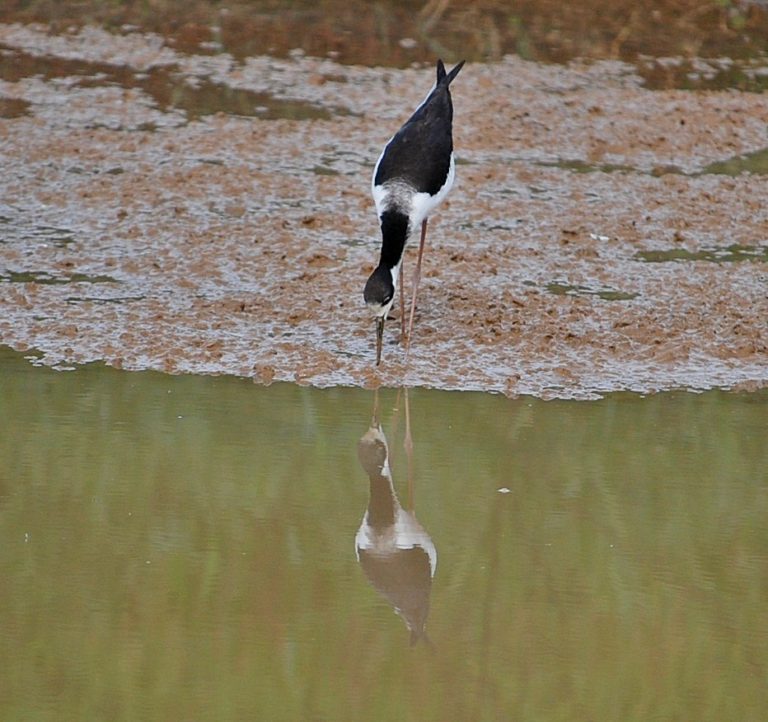
White-backed Stilt, juvenile showing all-black crown and gray area on mantle. (Laurentino, Santa Catarina, Brazil.) © Miguel Angelo Biz
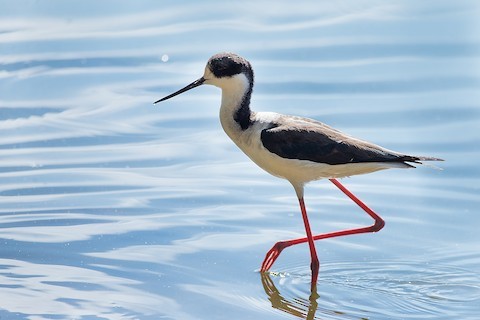
White-backed Stilt, immature with crown molting from black to white. (Parque Ibirapuera, São Paulo, Brazil; May 29, 2018.) © Luciano Bernardes

White-backed Stilt, juvenile showing mostly blackish crown. (Lagoa do Peixe, Rio Grande do Sul, Brazil; April 4, 2015.) © Cláudio Dias Timm

White-backed Stilt, showing remnants of black feathering on the crown. (La Serena, Coquimbo, Chile; September 10, 2013.) © Andrew Engilis
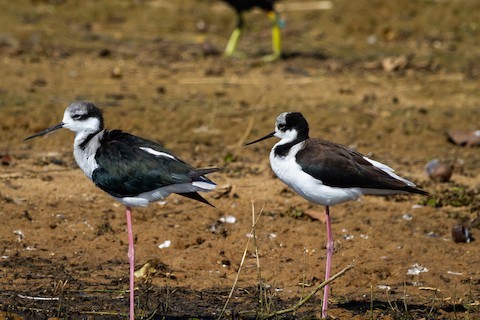
White-backed Stilt, immature male and female with crowns molting from black to white. (Represa de Guarapiranga, São Paulo, Brazil; July 12, 2018.) © Laerte Cardim
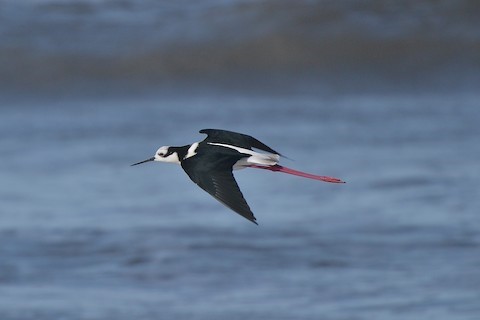
White-backed Stilt, showing white bar across mantle. (Balneário Pinhal, Rio Grande do Sul, Brazil; June 4, 2020.) © Fábio Luís Mello

White-backed Stilt, showing white bar across mantle (Cañada de Díaz, San Jerónimo, Santa Fé, Argentina; September 15, 2019.) © Ignacio Zapata
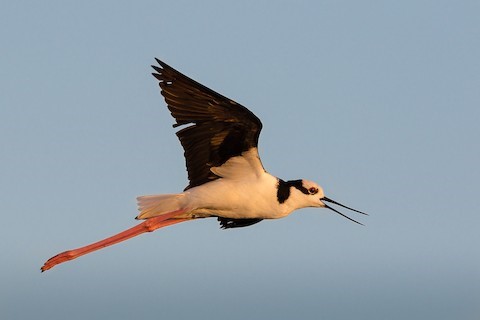
White-backed Stilt, showing black underwing with white inner coverts. (Miramar, San Justo, Córdoba, Argentina; January 19, 2016.) © Jorge Claudio Schlemmer
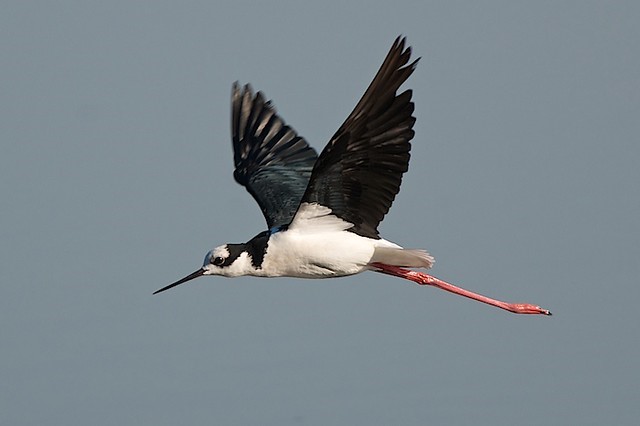
White-backed Stilt, showing black underwing with white inner coverts. (Pousada Embiara, Mato Grosso do Sul, Brazil; October 17, 2011.) © Peter Schoen

White-backed Stilt, showing black underwing with white inner coverts. (Jundiaí, São Paulo, Brazil; September 17, 2011.) © Roberto Gallacci
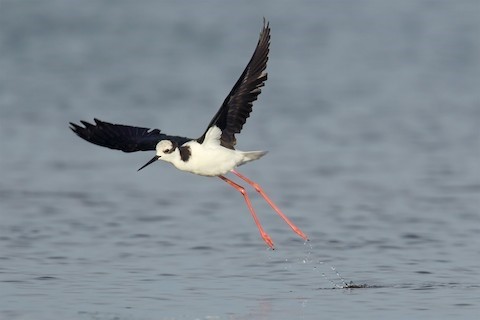
White-backed Stilt, showing black underwing with white inner coverts. (Miramar, San Justo, Córdoba, Argentina; February 25, 2018.) © Martjan Lammertink
Voice. Contact calls are mostly mellow, wheezy barking notes, repeated insistently, but at varying intensities: Sometimes squeaky like a bicycle horn or toy trumpet:
Cf. Black-necked Stilt. Black-necked and White-backed Stilts overlap widely across South America, in a band that encompasses much of Peru and Brazil. They are often considered conspecific and have reportedly interbred in Peru (and possibly also in eastern Brazil). However, their vocalizations seem to differ consistently—White-backed has a smoother, mellower voice compared to the harsh, sharp Black-necked—and most individuals are assignable to one form or the other (with the exception of a few aberrant individuals that seem to be hybrids). So provisional recognition as separate species seems justified, although further study of breeding populations could potentially yield evidence that they function as a single species.
Adult plumages differ noticeably in two ways. Most conspicuously, White-backed has a predominantly white crown whereas Black-necked’s crown is predominantly black. This is generally sufficient to distinguish adults. Less obvious is the eponymous trait of White-backed, a white bar across the upper back which separates the black of the neck from any black on the back.
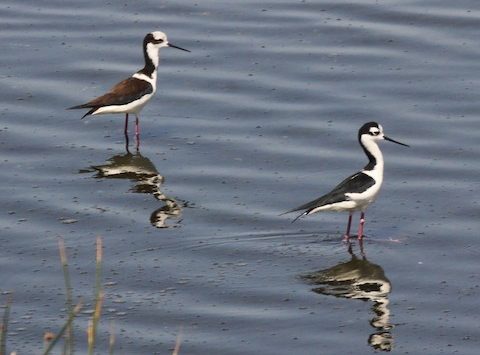
White-backed Stilt, female (left), with a male that appears to be a hybrid White-backed-Black-necked Stilt—it has a white bar across the back, but its head pattern is more consistent with Black-necked. (Humedales de Ite, Tacna, Peru; April 20, 2011.) © Larry Sirvio
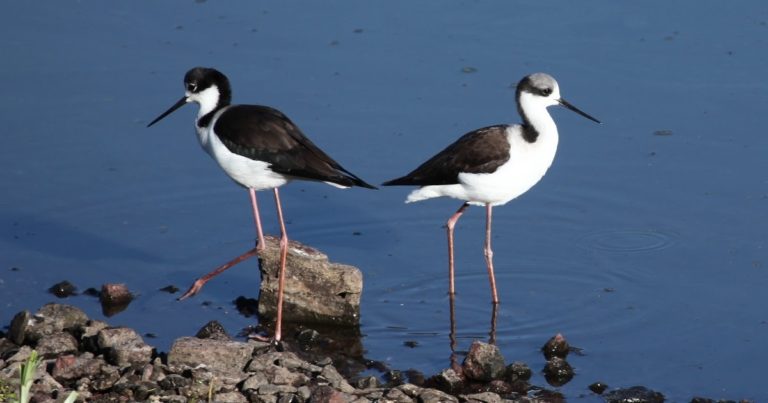
Immature White-backed Stilts—the bird on the left could be mistaken for Black-necked (and might be a hybrid), but it appears to have a white bar across its back and does not have white patch above the eye. © Marcelo Silva de Oliveira
Immatures can be more confusing, as both have a tendency to resemble the other species or form: immature Black-necked often has less extensive black (or dark-brown) on its head than adults; and immature White-backed typically has extensive black (or dark-brown) on its head—resembling Black-necked, but without the white patch over the eye. Immatures of both often have a partially pale bar across the mantle, effectively converging on an intermediate appearance.
Notes
Monotypic species. Often considered conspecific with Black-necked Stilt (H. mexicanus) due mainly to reported hybridization in Peru and possibly also eastern Brazil. Some authorities classify all of these forms as conspecific with the Old World Black-winged and Pied Stilts (himantopus and leucocephalus), known collectively as either Black-winged or Pied Stilt (H. himantopus).
References
BirdLife International. 2019. Himantopus himantopus (amended version of 2016 assessment). The IUCN Red List of Threatened Species 2019: e.T22727969A155440465. https://dx.doi.org/10.2305/IUCN.UK.2019-3.RLTS.T22727969A155440465.en. (Accessed October 14, 2020.)
eBird. 2020. eBird: An online database of bird distribution and abundance. Cornell Lab of Ornithology, Ithaca, N.Y. http://www.ebird.org. (Accessed October 16, 2020.)
Hayman, P., J. Marchant, and T. Prater. 2009. Shorebirds: An Identification Guide. Houghton Mifflin, Boston.
Schulenberg, T.S., D.F. Stotz, D.F. Lane, J.P. O’Neill, and T.A. Parker. 2007. Birds of Peru. Princeton University Press.
van Perlo, B. 2009. A Field Guide to the Birds of Brazil. Oxford University Press.
Wikiaves. 2020. Pernilongo-de-costas-brancas, https://www.wikiaves.com.br/wiki/pernilongo-de-costas-brancas. (Accessed October 16, 2020.)
Xeno-Canto. 2020. White-backed Stilt – Himantopus melanurus. https://www.xeno-canto.org/species/Himantopus-melanurus. (Accessed October 16, 2020.)
